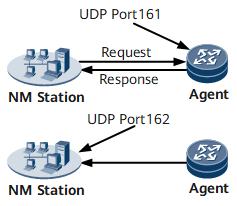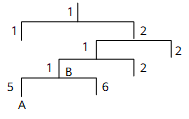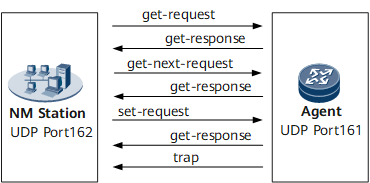Overview of SNMP
The NMS performs Get and Set operations on a managed device that runs the SNMP agent to manage objects. These objects are uniquely identified in the Management Information Base (MIB).
On a large network, if a fault occurs on a device, the network administrator cannot rapidly detect, locate, and rectify the fault as the device does not report the fault. This affects maintenance efficiency and increases maintenance workload. To resolve this problem, device vendors have provided network management functions in some products. The NMS then can query the status of remote devices, and devices can send alarms to the NMS when an event occurs.
SNMP operates at the application layer of the IP suite and defines the transmission of management information between the NMS and devices. SNMP defines several device management operations that can be performed by the NMS and allow devices to send alarms to the NMS to notify the NMS of device faults.
SNMP Components
NMS: sends various packets to query managed devices and receives alarms from these devices.
Agent: is a network-management process on a managed device. An agent has the following functions:
Receives and parses query packets sent from the NMS.
Reads or writes management variables based on the query type and generates and sends response packets to the NMS.
Sends alarms to the NMS when an event occurs. For example, the system view is displayed or closed, or the device is restarted. Protocol modules on the device define the conditions that lead to the alarms.
Managed device: is managed by an NMS and generates and reports alarms to the NMS.
Figure 1 shows the relationship between the NMS and agent.
MIB
To uniquely identify managed objects, SNMP organizes them in a hierarchical tree structure and identifies each one by a path starting from the tree root, as shown in Figure 2. The NMS uses the MIB to identify and manage device objects. The nodes on the tree are the managed objects.
As shown in Figure 2, object B is uniquely identified by a string of numbers, {1.2.1.1}. This number string is called an object identifier (OID). A MIB tree describes the hierarchy of data in a MIB that collects the definitions of variables on the managed devices.
You can use a standard MIB or define a MIB based on certain standards. Using a standard MIB reduces the costs on proxy deployment and therefore reduces the costs on the entire network management system.
SNMP Operations
SNMP uses GET and SET operations to replace a complex command set. The operations described in Figure 3 can implement all functions.
Table 1 lists functions of SNMP operations.
Operation |
Function |
|---|---|
GetRequest |
Retrieves the value of a variable. The NMS sends the request to a managed device to obtain the status of an object on the device. |
GetNextRequest |
Retrieves the value of the next variable. The NMS sends the request to a managed device to obtain the status of the next object on the device. |
GetResponse |
Responds to GetRequest, GetNextRequest, and SetRequest operations. GetResponse is sent from the managed device to the NMS and is processed by SNMP agent. |
GetBulk |
Is an NMS-to-agent request and functions the same as continuous GetNext operations. |
SetRequest |
Sets the value of a variable. The NMS sends the request to a managed device to adjust the status of an object on the device. |
Trap |
Reports an event to the NMS. |
Inform |
Reports an event to the NMS and requires acknowledgement from the NMS. |


